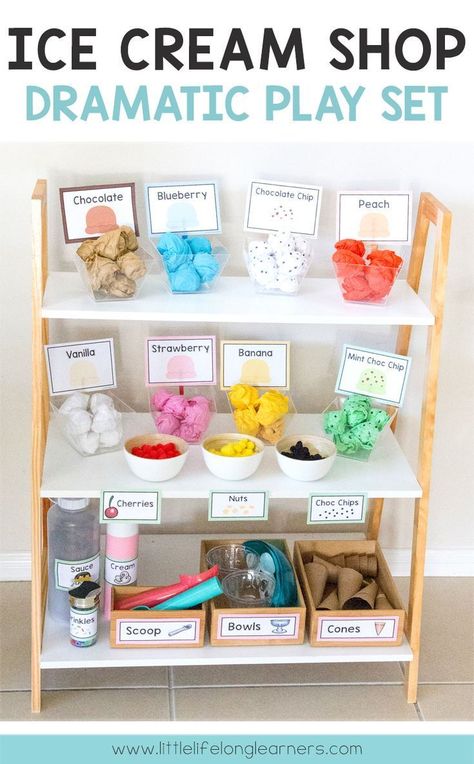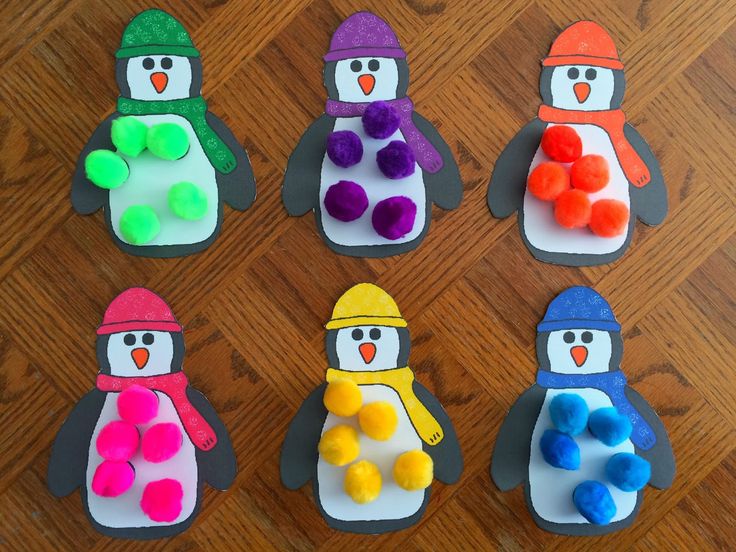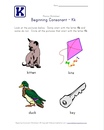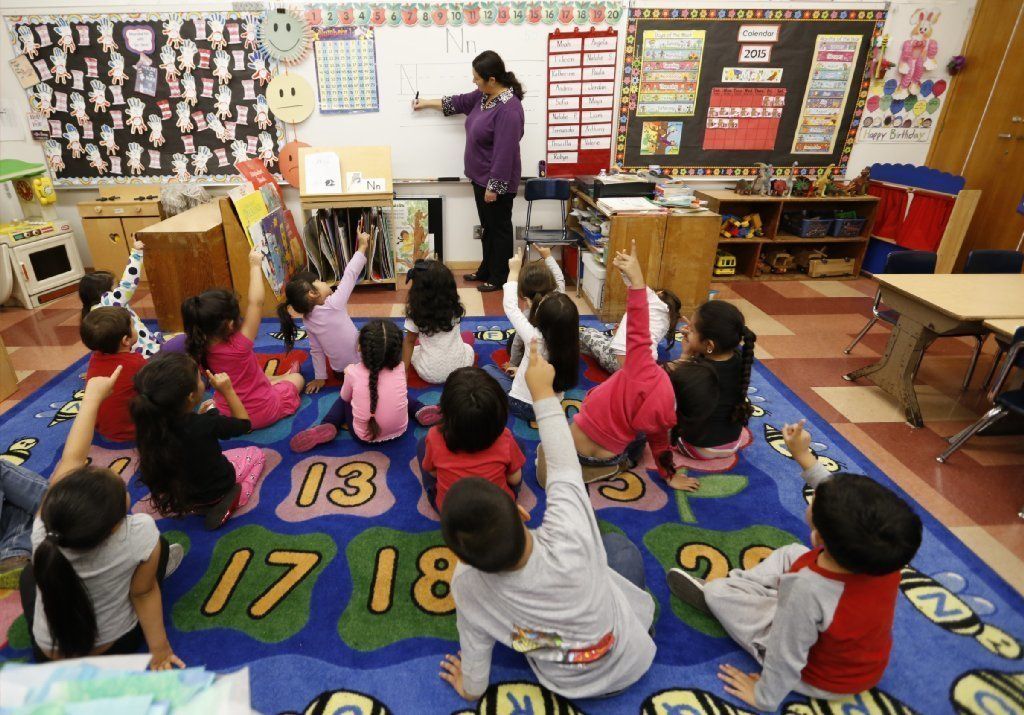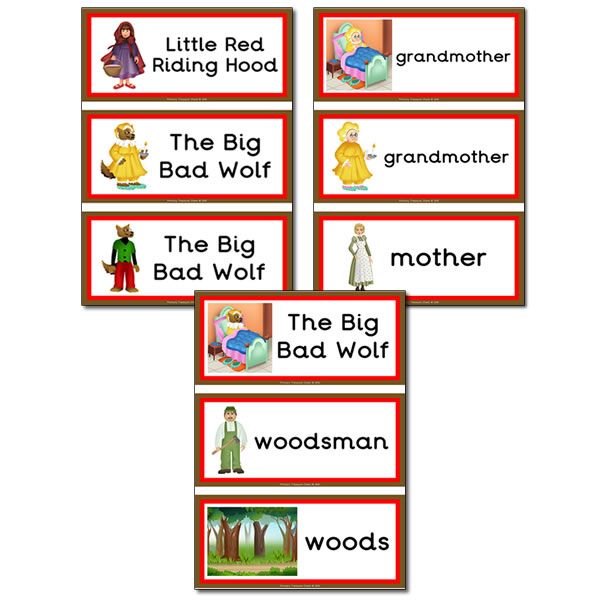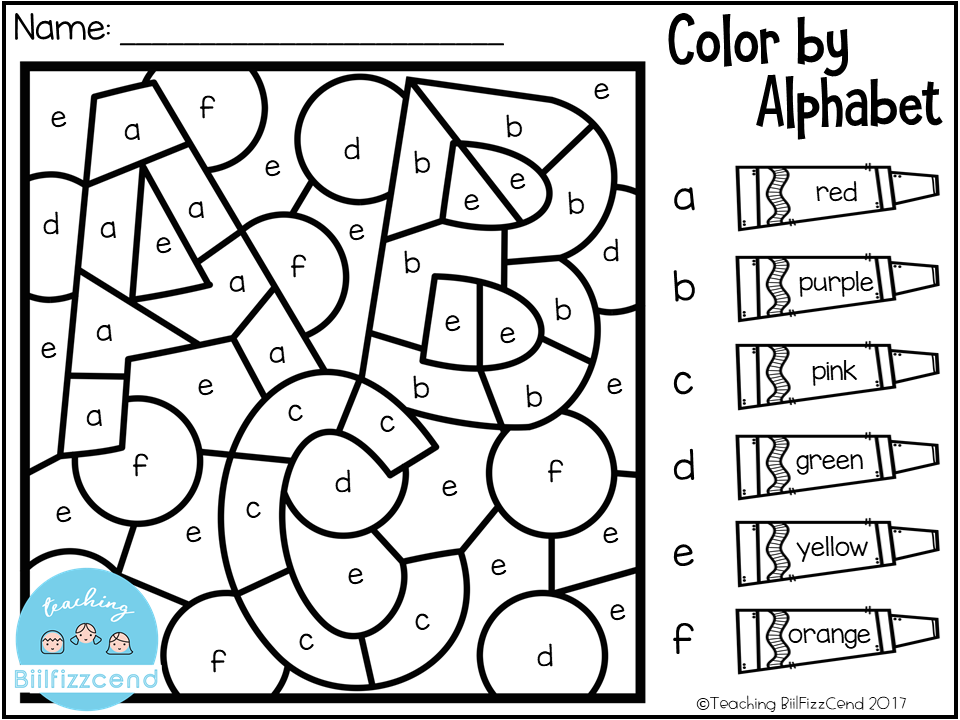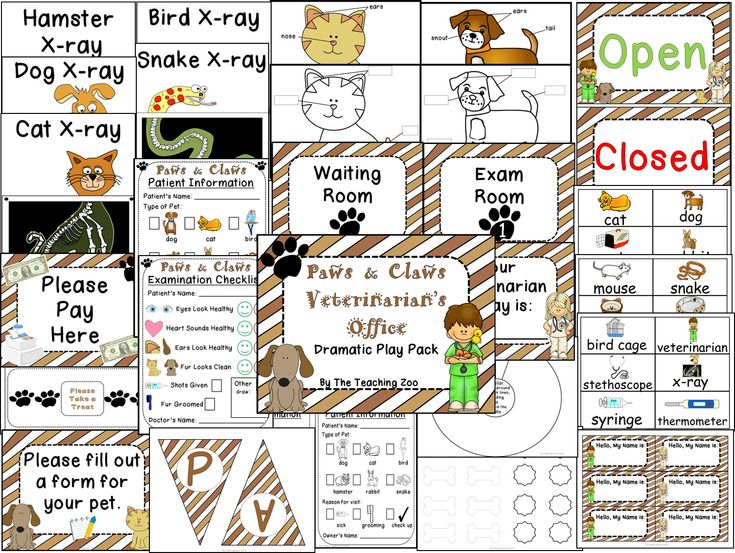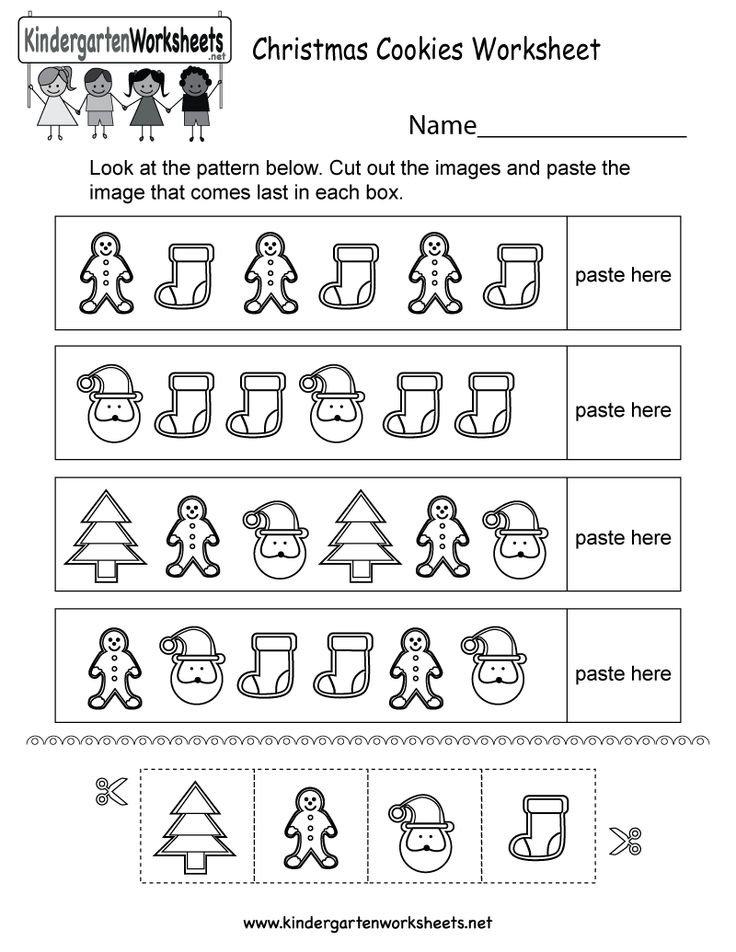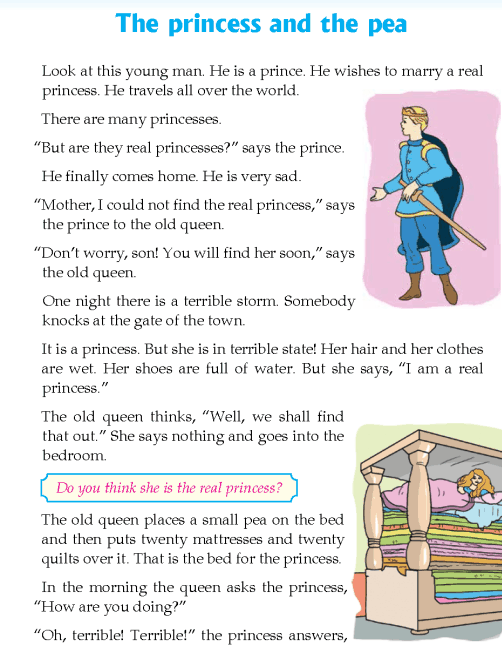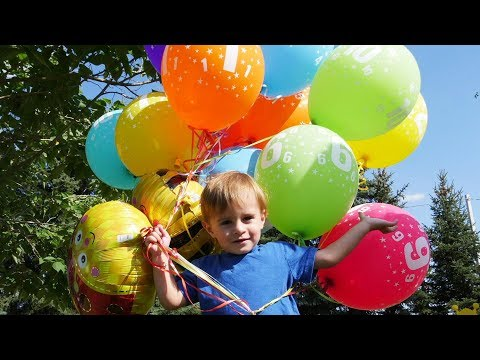Teaching your child to tell time
23 Fun Telling-Time Games and Activities (With Free Printables!)
It’s one of those skills kids are so proud to say they’ve mastered: “I know how to tell time!” Life gets easier too for parents and teachers once children are able to tell time. Of course, it’s simpler these days with digital clocks, but children still need to learn to read analog versions too. They also need to connect the dots between analog, written, and digital displays of time. Paper watches, rock clocks, and plastic egg puzzles are just some of the inventive ways you can teach your students about time. Try these fun interactive time-telling games and activities, and your students will be reading a clock in no time flat!
1. Make a paper clock
One of the trickier aspects of telling time is understanding how the number 1 also means 5 minutes, the number 2 means 10 minutes, and so on. This paper clock activity helps students make that connection. (Pro tip: Use paper plates to make this craft even easier.
)
Learn more: Natural Beach Living
2. Color the spaces to learn the hours
Another important concept kids need to grasp is how the spaces between the numbers work on an analog clock. These coloring games are a simple way to teach kids about telling time, but it helps drive the point home. Grab this free printable at the link.
Learn more: Around the Kampfire
3. Put a puzzle together
Use these telling-time puzzle games to demonstrate different ways of showing the same time. We especially love this version.
ADVERTISEMENT
Learn more: Elementary Nest
4. Wear paper watches
First, print and cut out the free printable paper watches. Draw hands on each clock face and record what time each student’s watch reads on a master record sheet. Have kids decorate their watch bands, then fasten them on their wrists and add the clock faces. Give each student a record sheet, then let them go around the room and ask each of their classmates, “What time is it?” They look at their classmate’s watch and record the time.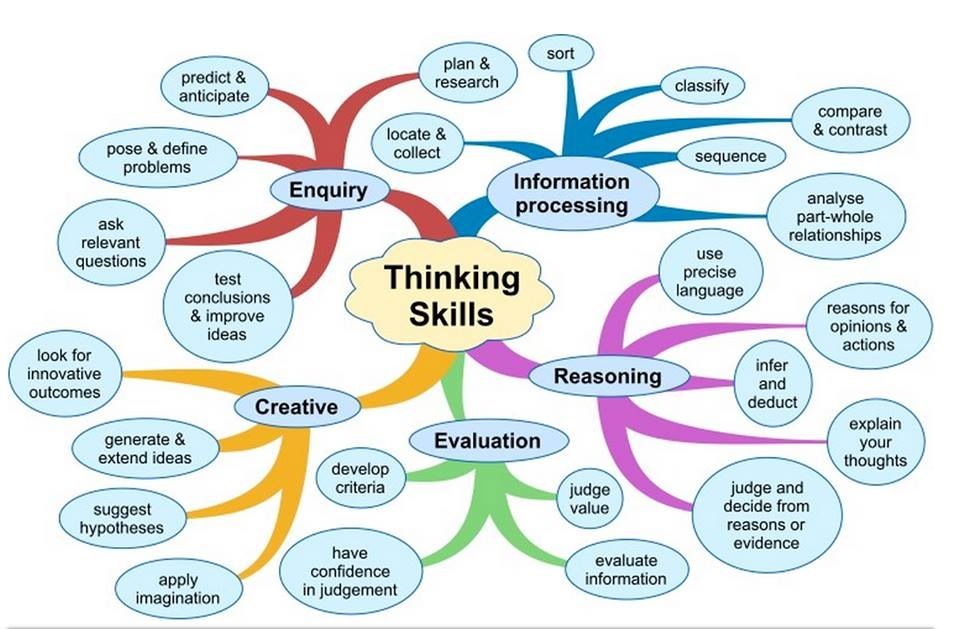 Check their results against your master.
Check their results against your master.
Learn more: 10 Minutes of Quality Time
5. Make a clock with linking math cubes
This telling-time game helps kids understand time both as a circular analog clock and a time line moving forward. Gather your math cubes and visit the link to see how it works.
Learn more: Teaching Special Thinkers
6. Make a rock clock
Part art lesson, part math, and part science—this is the ultimate time-telling activity. First, get outside to collect the sticks and rocks. Second, have them paint their rocks with acrylic paint. Finally, have them set their “clocks” to different times.
Learn more: Coffee Cups and Crayons
7. Take it outside with a Hula-Hoop clock
Pull out the sidewalk chalk and head outside for some time-telling practice. Hula-Hoops make perfect analog clocks, but if you don’t have any, you can still let kids play fun time-telling games by simply drawing circles instead.
Learn more: Lauren Oakes on Twitter
8.
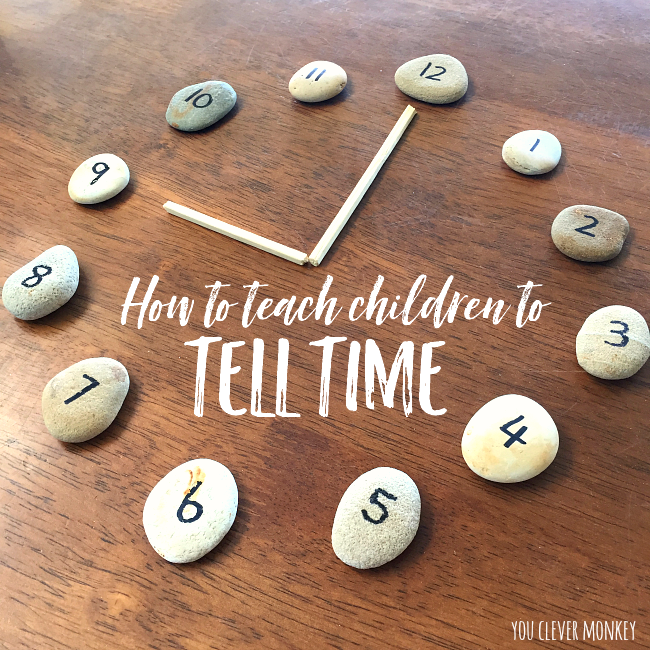 Set the time with play dough
Set the time with play doughCreate time-telling activity mats by printing a page similar to the one shown here and then placing it in a plastic sleeve or laminating it. Finally, challenge your students to roll out play dough to create the hands of the clock and “set” it to the designated time.
Learn more: This Reading Mama
9. Dance around for musical clocks
If your students love games like musical chairs, you can make it an educational time-telling activity. Start by printing out our free blank clock sheets here. Pass them out and have each student draw a time on their clock, then leave it on their desk. Give each student a recording sheet (included with the clock printable), then have them grab a pencil and get ready to move! Start the music and let kids dance around from desk to desk. Stop the music and instruct them to record the name and time on the clock of the desk in front of them. Start the music again and keep on going!
10. Turn a paper plate into a clock
We love how simple this project is to re-create since all you really need are some paper plates, markers, and a metal fastener.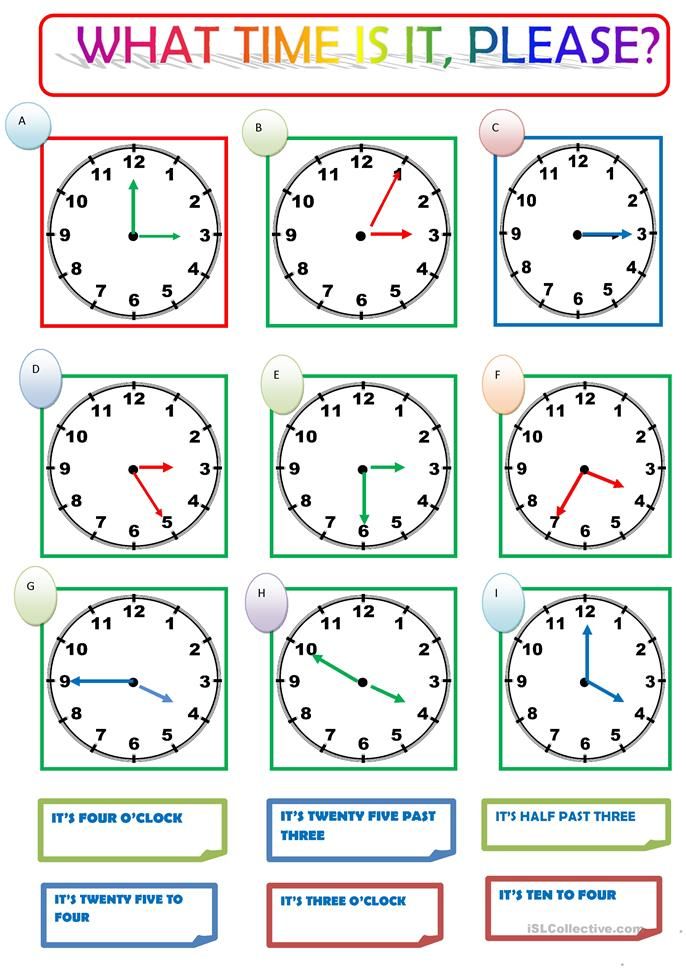 The numbers on the outer edge help your students make the connection between the minute hand and the spoken or digital time.
The numbers on the outer edge help your students make the connection between the minute hand and the spoken or digital time.
Learn more: PBS Kids
11. Shake up a carton of clocks
This awesome time-telling game also gives kids some practice at creating bar graphs. First, paste analog clock faces showing various times into the bottoms of an empty egg carton, and add a marble or other small toy. Kids shake up the carton, look to see what time the marble landed on, and graph their results.
Learn more: Primary Theme Park
12. Add a hook to the hour hand
This time-telling trick will help your students remember that as the hour and minute hands move around, the hour still belongs to the number behind. Clever!
Learn more: Around the Kampfire
13. Write the room with I Spy Time
Post paper analog clocks with times filled in around the room. Students find each clock and record the time on their record sheet. For more of a challenge, write “What will the time be in ____ minutes?” underneath each clock.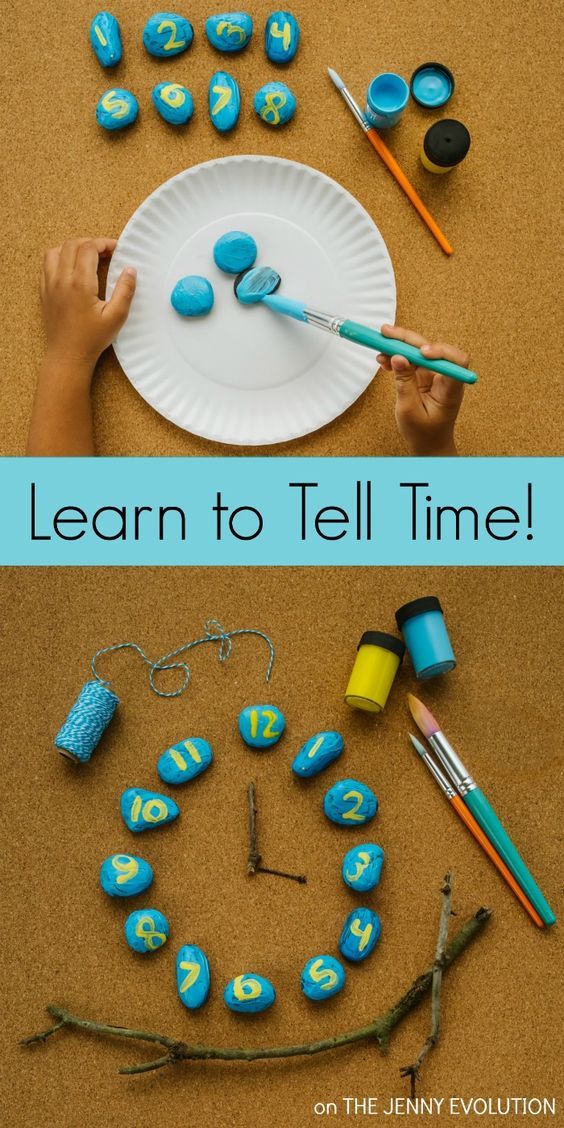 After students record the time showing, they calculate the future time too. Your students will have fun learning to tell time with these games.
After students record the time showing, they calculate the future time too. Your students will have fun learning to tell time with these games.
14. Match up plastic eggs
Plastic eggs have so many uses in the classroom. For time-telling practice, make them into games. Just draw analog clocks on one half and write times (in words or digital time) on the other, then have kids match them up.
Learn more: The STEM Laboratory
15. Turn your classroom clock into a flower
Turn a classroom wall clock into a pretty flower that will help your students make better sense of what they are looking at. We especially love the cute way the stem reinforces which is the hour and which is the minute hand.
Learn more: Facebook / The Best Ideas for Kids
16. Chill out with frosty clocks
Turn a snowman face into an analog clock! Use these free printables for a variety of wintry time-telling activities.
Learn more: Kindergarten Worksheet & Games
17.
 Calculate the duration of your favorite activities
Calculate the duration of your favorite activitiesReady to tackle elapsed time? Have students use this free printable worksheet to record the time they spend on three different activities, at home or at school. Think: basketball practice, dance class, watching their favorite TV show, eating a banana—or doing their homework.
18. Compete to win Telling-Time Bingo
Bingo games are always a blast in the classroom, and there’s a variation you can play that’s focused on telling time. These analog clock bingo cards are customizable, so you can set them to match whatever time skills your students are working on, whether it’s hours, half hours, quarter hours, or to the minute.
Learn more: Edu-Games
19. Race to beat the Rush Hour clock
Use toy clocks and a die to see who can reach a goal time first! Start at 12:00 and choose the target time. Students roll the die and move their clocks ahead the specified number of minutes on each turn. Students love these time-telling games!
Students love these time-telling games!
Learn more: Enza’s Bargains
20. Don clock headbands
These clock headbands are fun to wear, and they’re also perfect for a game of “What Time Am I?” Kids ask each other questions to try to guess what time is showing on their forehead clock.
Learn more: Primary Theme Park
21. Distinguish between A.M. and P.M.
This free printable is perfect for teaching the difference between A.M. and P.M. Students will relate to the activities on the worksheet and therefore connect the dots between what time of day they would typically do them.
Learn more: K5 Learning
22. Read books about telling time
Books are a great way to teach about so many different topics, and telling time is certainly no exception! Pick a few of your favorites and read them aloud during story time.
Learn more: The Best Children’s Books
23. Teach units of time with concentric circles
We love this activity since telling time is much more than just minute and hour hands on a clock.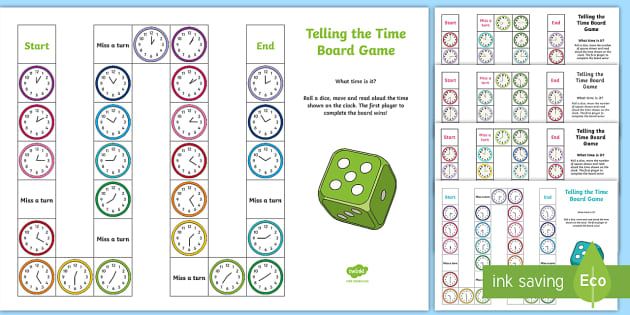 The visual representation of the smallest unit to the largest unit (and the different colors) will help students make sense of the various units of time.
The visual representation of the smallest unit to the largest unit (and the different colors) will help students make sense of the various units of time.
Learn more: Kids Activities Blog
How do you teach telling time? Come exchange ideas on the WeAreTeachers HELPLINE group on Facebook.
Plus, 18 Creative Ways To Dress Up Your Classroom Clock!
How to Teach Your Child to Tell Time
As adults, there are many skills we take for granted, but the truth is, we had to learn these skills, through hard work and perseverance. The quintessential example of this, of course, is telling time on an analog clock! As adults, we seldom think of the mental somersaults required to tell time on a traditional clock, but that changes when you have children. Read below to learn how to teach your child to read a clock, and help them get a jump start on their own education and independence.
Is Your Child Old Enough to Tell Time?
As a child's brain develops, their neural connections become better equipped to comprehend concepts, that once were too advanced for them.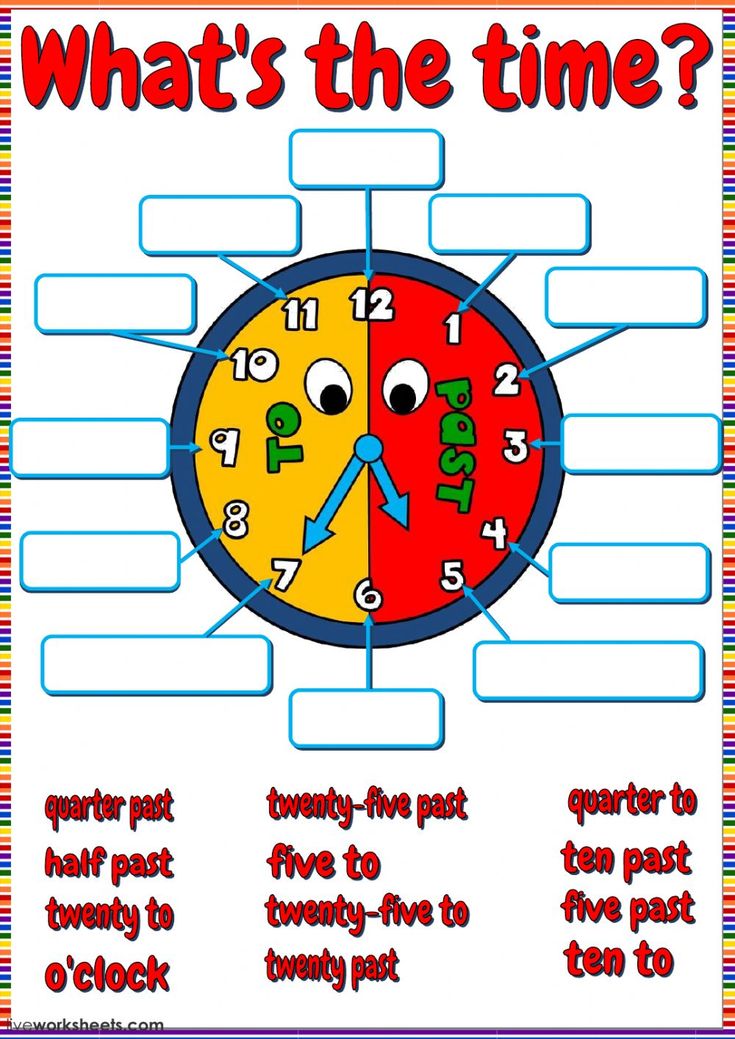 For example, the idea of object permanence (and the end of fascination with peek-a-boo!) or understanding the reality of dangers and consequences are intellectual growths we acquire with age. The same holds true for telling time.
For example, the idea of object permanence (and the end of fascination with peek-a-boo!) or understanding the reality of dangers and consequences are intellectual growths we acquire with age. The same holds true for telling time.
So, how old should your children be when you teach them about time?
There are a few key ages where you should teach your child about time -- but remember this is an incremental process:
- Age 5-6:
Children should be able to read the hour and half hour markers on an analog clock, and draw the corresponding times as well. - Age 6-7:
Children should know the number of minutes in an hour and the number of hours in a day.
Children should be able to tell / draw time in five minute increments,
Children should be able to comprehend quarter to / quarter past concepts - Ages 7-8:
Children should be able to read an analog clock, using 12 hour clocks, 24 hour clocks, and Roman Numerals (I-XII).
Children should be able to compare time (by hours, minutes, and even seconds).
Children should be comfortable using time-specific vocabulary (o’clock, a.m./p.m., morning, afternoon, noon and midnight).
Teaching Your Child to Tell Time
Before a child can tell time, they need to understand the basics of what goes into telling time. Follow the below processes to ensure your child has the foundational knowledge to read a clock:
- Practice Counting to 60: Before they can run, they have to walk. Similarly, before they can tell time, they have to know all their numbers up until 60, comfortably. Help them learn by having them read the numbers from a chart, write them, and recite them from memory.
- Practice Counting by Fives: Once your child has learned to count to 60, teach them to count to 60 by fives. Your child will have mastered this when they can recite and write from 0-60, from memory.
Check YouTube for some catchy tunes to ease the process.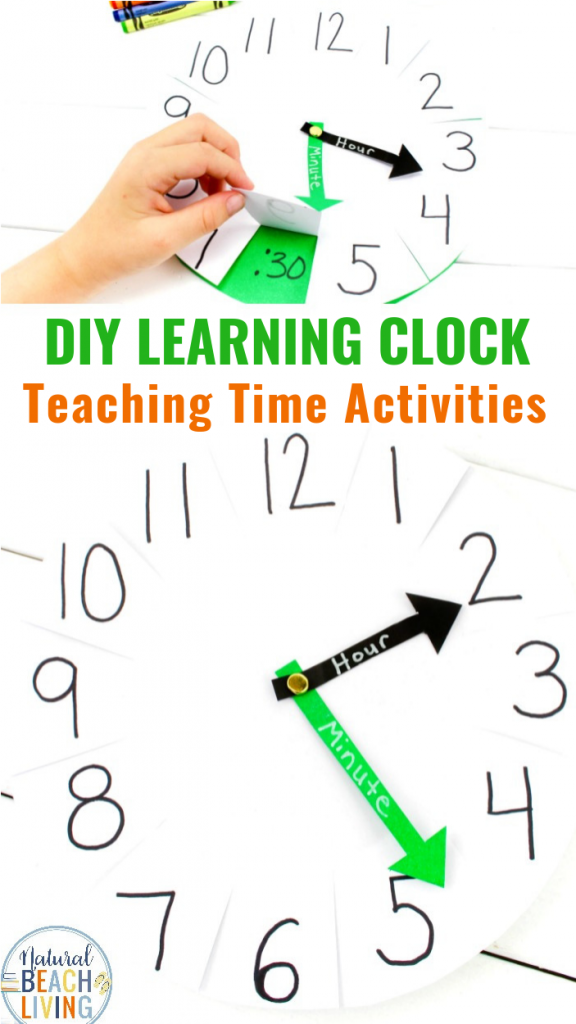
- Introduce Your Child to the Concept of Time: Time, is actually quite a radical process (one that took humans a few thousand years to understand and record).
Start by introducing your child to the concepts of morning, noon, evening, and night time.
Then, ask your child when certain routine activities happen. (i.e. "When do we eat breakfast?" or "What do we do in the morning?").
Once your child can understand these divisions of the day, they're on track to understanding time! - Make a Model Clock Together: Pick up a paper plate, and enthusiastically tell your child "Today we're making our own clocks!" Keep an analog clock next to you, to use for reference. There are many websites available with free lesson plans on how to do this at home.
Be sure to focus on the important markers (12, 3, 6, 9), as well as the Hour Hand and Minute Hand during construction.
Afterwards, try a few simple examples of setting and telling times.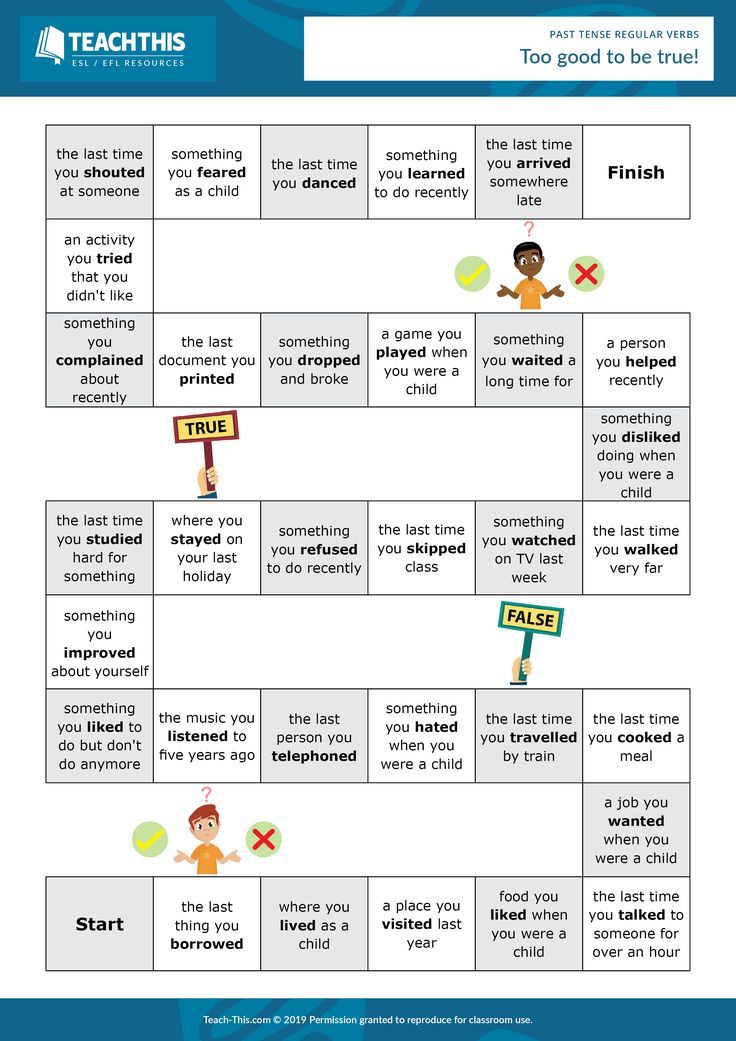 To make it fun for your child, take turns with setting and answering (don't be afraid to get a few wrong to show them that it's okay to make mistakes)
To make it fun for your child, take turns with setting and answering (don't be afraid to get a few wrong to show them that it's okay to make mistakes) - Connect Time to Their Daily Routine: As your child continues to learn about time, keep connecting time with their daily routines -- but now go more advanced. For example, ask them what time school ends. Then, ask them to show you the corresponding time on the model clock.
Try doing this a few times every day (with different examples).- Start With the Hour Hand: As the easier of the two hands to grasp, start teaching your child how to use the hour hand of the clock so they can relate each number to an hour of the day.
Model how to read the hour hand a few times ("I see the hour hand is pointing to _, so I know it is _ o'clock!")
Then, as they start to pick it up, ask them to show you certain times on the clock. - Practice With the Minute Hand: The minute hand is more difficult for children to understand.
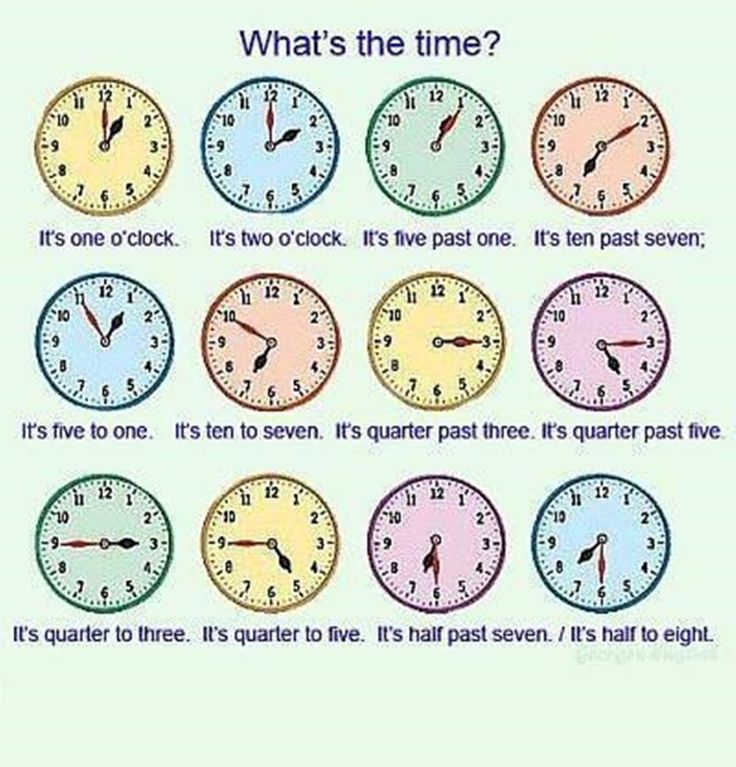 Explain to your kids that since there are 60 minutes in an hour, 1 means 5, and 9 means 45. This can be extremely frustrating for most kids -- who like to think of math as black and white, so please ease them in to this and be patient.
Explain to your kids that since there are 60 minutes in an hour, 1 means 5, and 9 means 45. This can be extremely frustrating for most kids -- who like to think of math as black and white, so please ease them in to this and be patient.
Model how to read the minute hand ("I see the minute hand is pointing to x, so I know it is _:x*5 o'clock!")
If your child is really struggling, just draw the number of minutes around the clock and have them use that as a reference.
Remember, telling time is quite a difficult process and it will take your child some time.
- Start With the Hour Hand: As the easier of the two hands to grasp, start teaching your child how to use the hour hand of the clock so they can relate each number to an hour of the day.
- As your child slowly builds confidence with the time-telling process, encourage them and continue to practice with them regularly. If they make mistakes, simply model the correct way to do it and try again.
Remember, all good things do take some time :)
Sources
"Activity: Make A Clock!" [Web]. Retrieved from https://www.education.com/activity/article/clock_first/
Busythings Ltd (2015).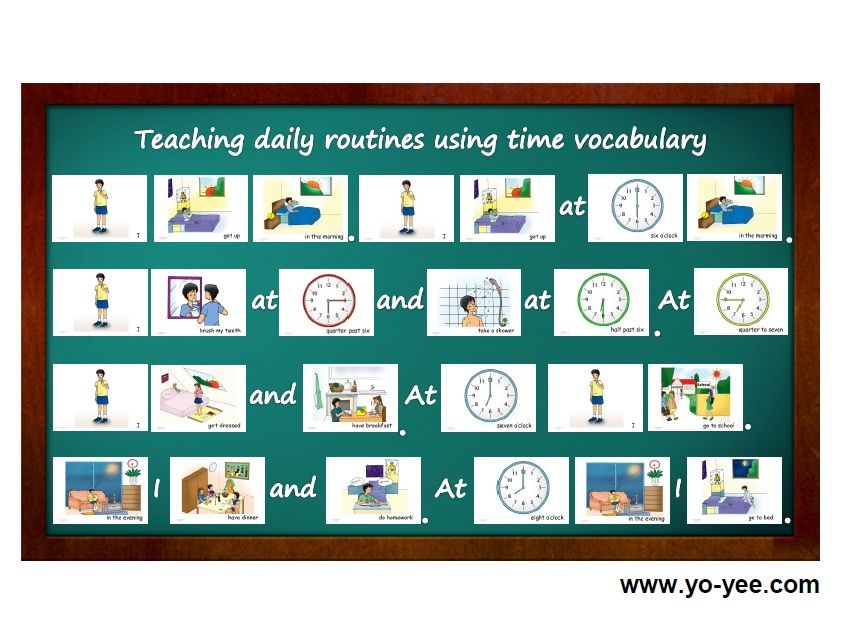 "Teaching Children How to Tell the Time: Hints and Tips." [Web]. Retrieved from https://www.busythings.co.uk/blog/teaching-children-how-to-tell-the-time-hints-and-tips/
"Teaching Children How to Tell the Time: Hints and Tips." [Web]. Retrieved from https://www.busythings.co.uk/blog/teaching-children-how-to-tell-the-time-hints-and-tips/
Palomino, C (2019). "How to Teach Kids to Tell Time." [Web]. Retrieved from https://www.wikihow.com/Teach-Kids-to-Tell-Time
Wikipedia (2020). "History of Timekeeping Devices." [Web]. Retrieved from https://en.wikipedia.org/wiki/History_of_timekeeping_devices#cite_note-bruton-6
1
Topics: East Brunswick, Learning, Children, Math Genie, Parents, South Plainfield, Marlboro, Development, North Brunswick, Parenting, Strategies, Child Success, Better Parenting, Child Skills, Child Rearing, Teaching Children, Child Education, Child Needs, Critical Thinking, Time Management Skills, Confidence, Promoting Learning, Best Practice, Learning Strategies, Morganville, First Grader, Foundational Skills, Basic Skills, Positive Reinforcement, Parenting Tips, Parenting Skills, Parental Milestones, Second Grade, Second Grader, First Grade, Fun Math, Third Grade, Early Learning, Number Theory, Word Problems, Parent-Child Relationships, Plainsboro, Homework Help, Growing Minds, Telling Time, Elementary School, addition, neurological, brain, 2019, what works in 2020, subtraction, multiplication, division, neuroscience, vocabulary
6 tips on how to teach your child to tell the time - and turn this activity into a fun game
Why is half past six 06:30 and not 7? And on an electronic clock, is it generally 18:30? Why does time increase when we fly east? These questions confuse children. We tell you when and how to talk to your child about time - and teach him to be punctual.
We tell you when and how to talk to your child about time - and teach him to be punctual.
When to teach a child to tell the time
A child needs a number of skills to tell the time by the clock:
- be able to count within 30, and preferably 60;
- determine which number is greater and which is less;
- navigate in space, know where the right, left, top, bottom are;
- basicly navigate in time, understand when morning, afternoon, evening and night come.
A child usually acquires these skills between the ages of 5 and 7. However, you can begin to introduce the child to the clock in the process of learning these concepts.
How to get started with time
The first steps in the study of time do not have to be connected with numbers. The main thing is to show the child that time is part of our daily life.
For example, pay attention to the child what time it is on the clock at the moment when he wakes up, brushes his teeth, goes to kindergarten or school, returns from there, goes to bed. Ask him to restore the sequence of habitual actions and distribute what is usually done in the morning and what is done in the evening. If the child makes a mistake, gently correct him. Or you can try to confuse him, for example, by asking: “We all have dinner in the morning, right?” The main thing then is to explain what the mistake was.
Ask him to restore the sequence of habitual actions and distribute what is usually done in the morning and what is done in the evening. If the child makes a mistake, gently correct him. Or you can try to confuse him, for example, by asking: “We all have dinner in the morning, right?” The main thing then is to explain what the mistake was.
In a situation where you and your child are late (for example, standing in a traffic jam), calmly explain that usually the journey takes you a certain amount of time, and now - so many minutes more . Or indicate that the child has 20 minutes for cartoons: let him mark the time, and you set a timer. So he will gradually feel the importance of time, and he will have the motivation to study it.
How to explain to a child what time it is on the clock
When your child has a basic understanding of time, it's time to start teaching him to tell time by the clock. You can study a real clock with hands or make a cardboard model with your own hands.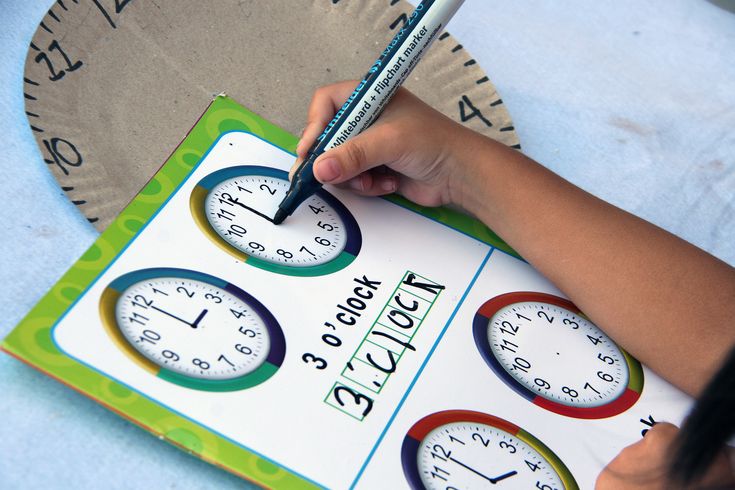 To do this, you need:
To do this, you need:
- Make a dial - it can be a circle cut out of cardboard, or a disposable plate.
- Put numbers around. To make it even, it is better to draw a vertical and horizontal reference line with a pencil through the center - they will have the numbers 12, 3, 6 and 9. Each quarter of the circle must be divided into three parts and the remaining numbers should be written on their borders.
- Draw and cut out the hands: the hour hand is shorter and the minute hand is longer. They can be made of cardboard of different colors.
- Attach the hands to the center of the dial with a push pin or wire.
The numbers can be designed the way the child likes: cut out of paper, placed on multi-colored figures or molded from plasticine. You can add associations to them, which usually happens to the child at each of the hours: he sleeps, eats, walks.
On the outer circle of the dial (both homemade and real), you can add stickers with the time on the electronic clock - next to the hour it will be 13, with two - 14, and so on.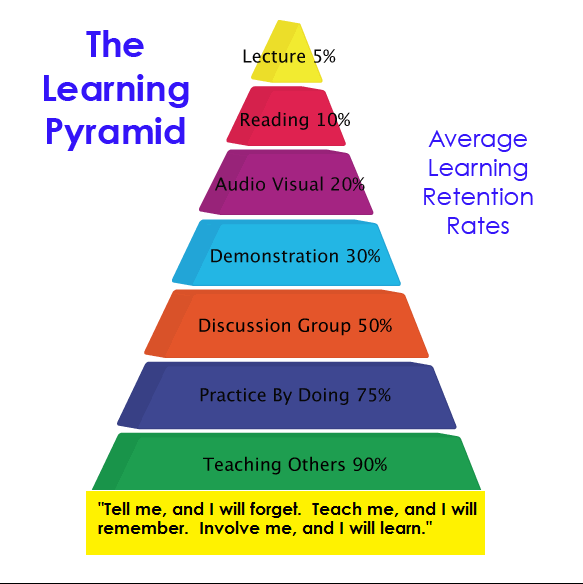 So the child will remember these correspondences over time. You can also add the designations of minutes: 10, 15, 20, 30, 45.
So the child will remember these correspondences over time. You can also add the designations of minutes: 10, 15, 20, 30, 45.
When the clock is ready, it is worth showing the child how the hands will be located in different circumstances: if it is exactly one in the afternoon, half or a quarter to two, fifteen minutes to three. Ask him to memorize the location of the hands and then line them up on his own when you verbally name the time.
On a real watch, you can invite the child to observe which of the hands runs faster - hour or minute, and discuss together why this happens (after all, an hour is 60 times longer than a minute, and when the hour hand made only one circle, the minute hand managed to turn around as many as 60 times ).
"Time is the first hour" - how to explain it
Adults use time concepts that often only confuse the child. For example, why is half past one 1:30 and not 2:30? Or what does “the first hour has gone” mean - where did he go, why is he the first and what time is it then?
You can solve the problem with the help of a pie or pizza - they need to be cut into two halves and explained: “Let's pretend that you are an hour.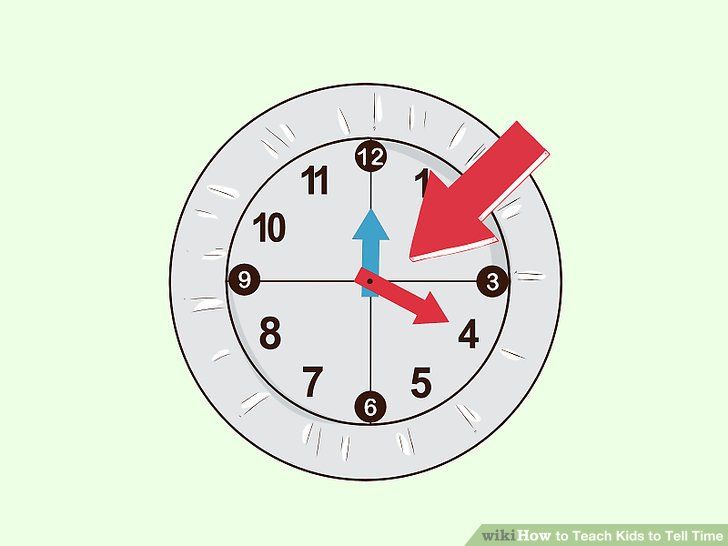 This half is yours, and this is half of the other person. You already have a piece: it means you are an hour and a half, 01:30. When you have received your share and at 01:30, the time comes for the second to eat his half - half past one. The same with quarters: the child will get a quarter of a pie or pizza - and a quarter of the second will come.
This half is yours, and this is half of the other person. You already have a piece: it means you are an hour and a half, 01:30. When you have received your share and at 01:30, the time comes for the second to eat his half - half past one. The same with quarters: the child will get a quarter of a pie or pizza - and a quarter of the second will come.
But the concept of “a quarter to two” cannot be explained in this way
You can just imagine that it's almost two o'clock in the afternoon, but a slice of pizza is missing until the exact time. If you close your eyes to this and count "a quarter to a minute", then just two will work out.
To reinforce these concepts and not overeat pizza with pies, you can draw circles and hatch them in halves and quarters. Coloring pages will also help you remember five-minute intervals: by analogy with halves and quarters, you can discuss what time it is when adults say “five minutes to three” or “five minutes past seven”.
Concepts like "the first hour has begun" can be represented with the help of a relay race of runners.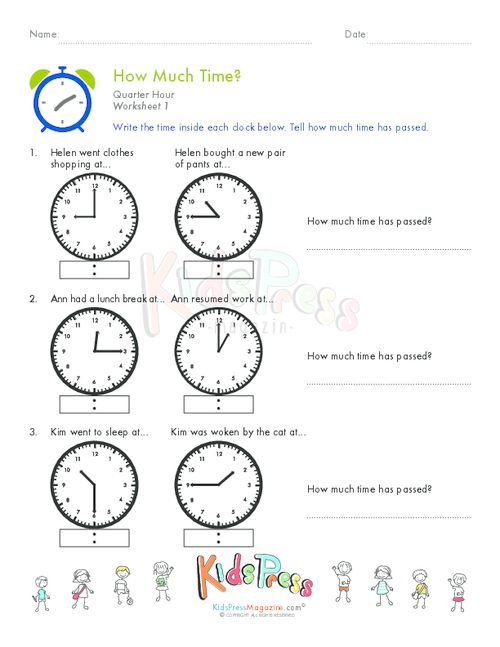 If the first hour has started, then the clock is a little over 01:00. At a distance of 01:59, he comes to the finish line, then the second hour starts. A child can also draw a runner on the dial - and dream up what will happen if the runner stops (or the clock breaks).
If the first hour has started, then the clock is a little over 01:00. At a distance of 01:59, he comes to the finish line, then the second hour starts. A child can also draw a runner on the dial - and dream up what will happen if the runner stops (or the clock breaks).
How to teach a child to tell the time using an electronic clock
Pay attention to the child that on a regular watch each digit is repeated twice a day. For example, 12 o'clock happens at noon and midnight, so we distinguish between "2 o'clock in the afternoon" and "2 o'clock in the morning." But on an electronic clock, this is not necessary: each of the 24 hours of the day is taken into account there.
Now you need to count together with the child in a circle of the dial from 1 to 12, and then continue counting from 13 to 24 (do not forget to note that on the electronic clock instead of 24 hours 00:00 is used and the countdown of a new day begins).
Photo: Elizaveta Galitckaia / Shutterstock / Fotodom The resulting figures should be signed on the drawn dial.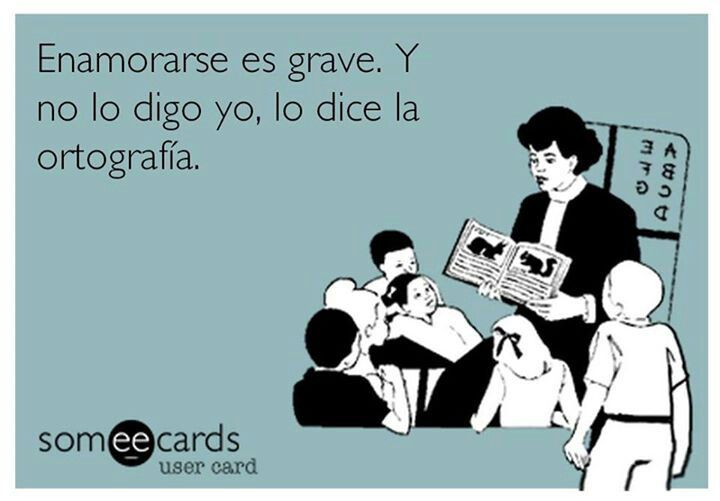 And to better remember them, we offer a game. You will need dice: one pair will indicate hours, the other - minutes. Let's drop the first pair. Dropped, for example, 1 and 6, which means 16 hours. Now the second pair, on it 4 and 5 - 45 minutes. We draw or show the resulting time on a homemade dial. Happened? And if you compete for time?
And to better remember them, we offer a game. You will need dice: one pair will indicate hours, the other - minutes. Let's drop the first pair. Dropped, for example, 1 and 6, which means 16 hours. Now the second pair, on it 4 and 5 - 45 minutes. We draw or show the resulting time on a homemade dial. Happened? And if you compete for time?
What else to tell your child about time
There are many interesting facts about time. With stories about them, you can interest the child, push him to explore the world. If he asks a "stupid" question, do not rush to brush it off - it is better to share your knowledge or look for the answer together. For example:
- Why, when we fly in an airplane to some countries, do we change the time? Because the planet rotates around its axis and the sun in different parts of the Earth rises at slightly different times, so the entire globe is divided into time zones. When we get to another time zone, we need to check what time it is there.
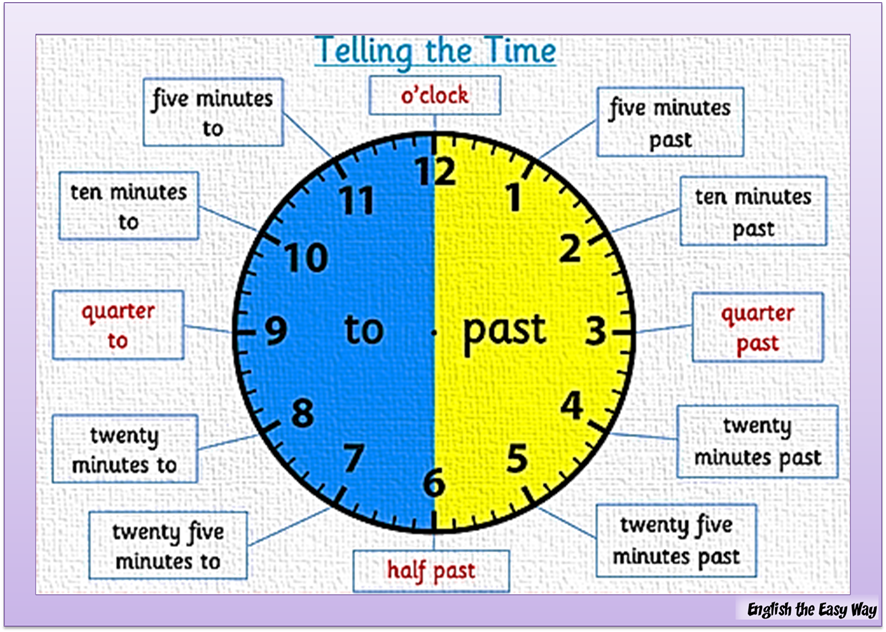 And in some countries, they change the clock to adjust to the length of the day, because in winter the day is much shorter than in summer.
And in some countries, they change the clock to adjust to the length of the day, because in winter the day is much shorter than in summer. - Why are the watches so different: on the arm, on the wall, in the phone? People invented watches a long time ago, and even mechanical watches did not exist back then. They were guided by the sun - there is a sundial even now. There are also hourglasses, water clocks, candle clocks, in which time is determined by the rate at which the candle melts. Mechanical watches were invented about 7 centuries ago, and electronic watches were invented not so long ago. Each person uses the watch that is more convenient for him.
- Why do I sometimes wake up before the alarm goes off? Because inside a person there is an internal biological clock - it is connected with sunlight and natural cycles that run daily. If you develop a mode, the alarm clock may not be needed at all.
When the child is older, you can tell him about the theory of relativity - that time can flow in a completely different way than we are used to.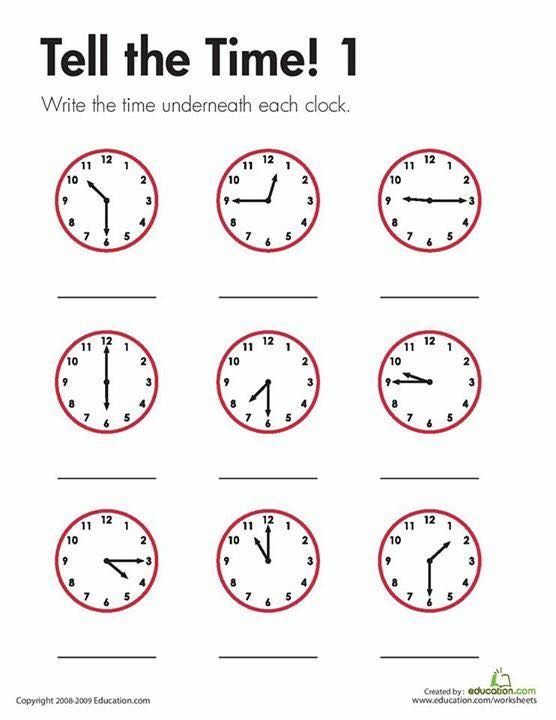 And dream together so that it flows so that no one is ever late!
And dream together so that it flows so that no one is ever late!
Cover image: Evgeniia Primavera / Shutterstock / Fotodom
How to teach your child to tell the time with hands
You tell your child you'll be there in 3 minutes and he runs after you crying. The kid does not understand what 3 minutes means. Suddenly you leave for the whole day?
The child went to the first grade, but he gets tired out of habit, cannot organize his time. He wants to play, watch cartoons, but he also needs to prepare for classes and go to bed on time.
If the baby knows that 3 minutes is not such a long time, he can wait.
If a younger student knows how to tell the time, he will be able to organize his day on his own.
So how do you teach a child to tell the time by the clock? Let's give some recommendations.
At what age should a child be taught to tell time?
A child of one and a half years old understands that there are certain time intervals: dad comes home from work in the evening, day turns into night.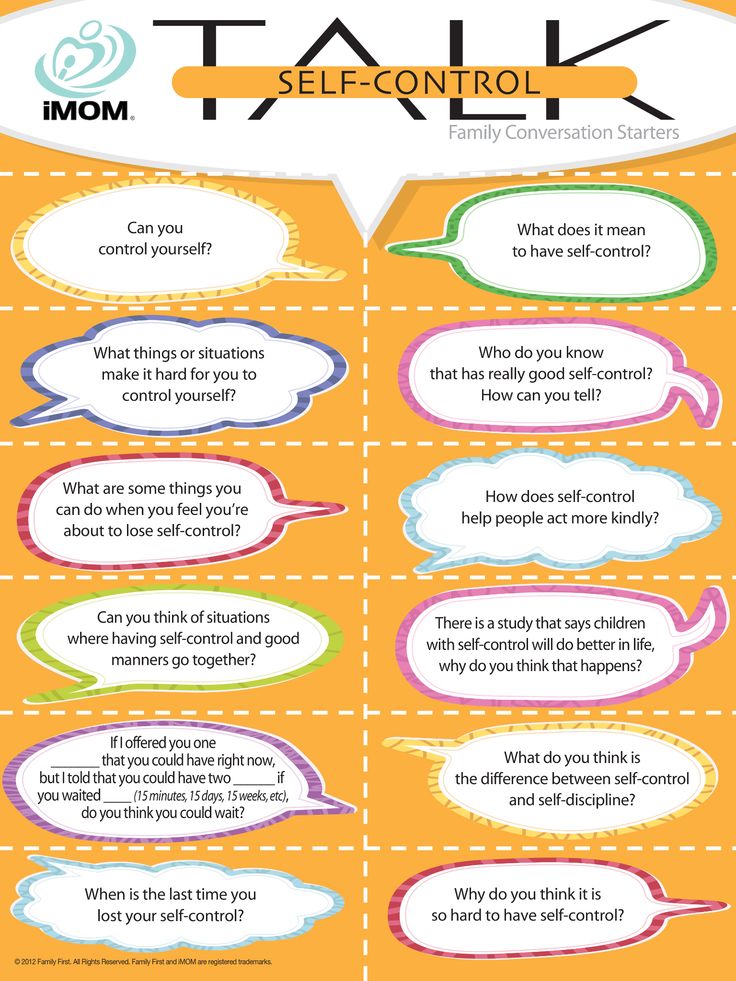 At 2-3 years old, he begins to perceive "temporary" words: tomorrow, yesterday, today, now, later.
At 2-3 years old, he begins to perceive "temporary" words: tomorrow, yesterday, today, now, later.
It is possible to start acquaintance with the concept of time when the child knows numbers and two-digit numbers, does not confuse yesterday and tomorrow. As a rule, by the age of 6, children already know and understand these words, so they can move on.
However, all children are different, and it is impossible to say with certainty that it is necessary to master such knowledge at the age of 6. If a four-year-old kid is familiar with numbers and shows interest, start learning.
Before you start learning
Before learning to tell time with a clock, prepare your child to understand time.
- The first thing a child needs to understand is that time is abstract, so you can't taste, touch or see it.
- Time cannot be stopped. Today is the present, yesterday and a year ago is the past, and what will happen tomorrow and then is the future. Reinforce what was said with facts: “Now we are drawing”, “Look at the photo of what you were 2 years ago”, “Let's go to the park on the weekend”.
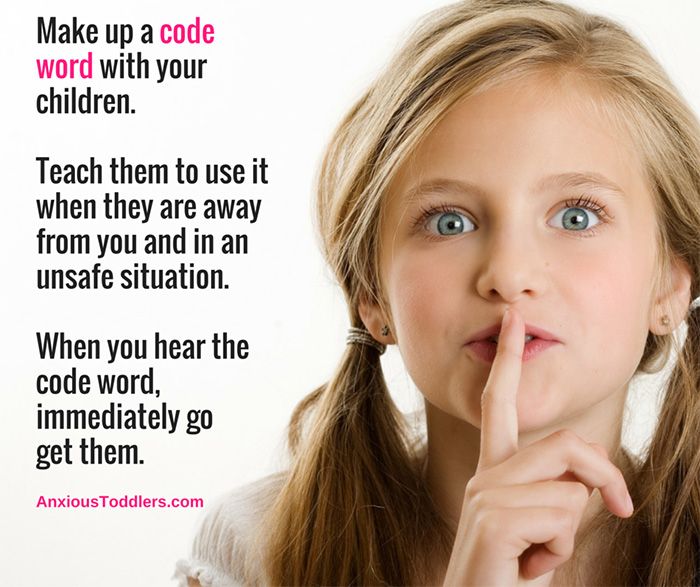
- You can play the game it was, it became, for example: first there was a seed, then - a sprout, even later - the sprout will become a tree.
- The next step is to learn the seasons with your child. As a rule, there are no difficulties here, and children quickly remember that it snows in winter, everything blooms in spring, we swim and sunbathe in summer, and in autumn we harvest. Do not forget to clarify that each season consists of three months, months - of weeks, and weeks - of 7 days.
- We find out that the day consists of morning, afternoon, evening and night. We say there are 24 hours in a day. To remember, arm yourself with educational pictures or associations: in the morning you go to kindergarten, have lunch at 12 noon, return from kindergarten at 6 pm, and so on.
Explaining to a child what time is
Usually, children 2-3 years old do not notice the passage of time at all: they can stop playing or watching a cartoon only if this activity is boring for them, or it is interrupted by their parents.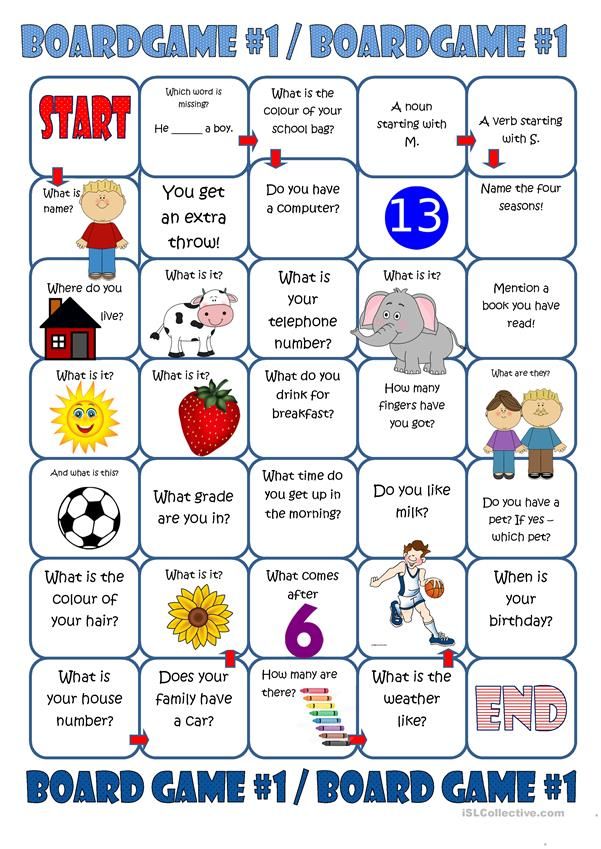 In fact, the time of the child is regulated by an adult.
In fact, the time of the child is regulated by an adult.
Older children are able to recognize that some action lasts a long time, or passes quickly.
To make it easier for the child to understand the passage of time, sit him down for 1 minute of “doing nothing”. Ask how he thinks the time went. Also set aside exactly one minute for the ball game and ask how the time went this time. Don't forget to draw an important conclusion: when you are passionate about something, time passes faster.
An hourglass can be purchased and timed for brushing teeth, getting dressed, etc.
Hang a large wall clock in your child's room. Pay attention to the child that he usually goes to bed at 9 pm, wakes up at 7 am, and his favorite cartoon starts at 19.00.
Teaching a child to tell the time by the clock with hands
When the child has an idea of what time is, you can move on to the next level — tell the time by the clock.
1. First, we form the concept of a dial. Be sure to consider what numbers are present, name them and remember how they are written.
Be sure to consider what numbers are present, name them and remember how they are written.
2. Note the types of hands and say that a wide and short hand is needed to determine the hour, and a long and thin hand is needed for minutes. Add that there is also a second hand (one second is the time it takes the baby to clap his hands).
3. Determine in which direction the arrows are moving; along the way, explain the concepts of "clockwise" and "counterclockwise".
4. First, we learn to determine only the hours on the dial, without minutes. To do this, look at what number the small arrow points to. We bring this skill to automatism. For clarity, you can not only call what time it is, but also draw to use visual memory.
5. The next step is to get to know the minute hand. Tell your child about the similarities between the hour and minute hands (both start at 12) and the differences (the minute hand is much faster: for the hour hand to move an hour, the minute hand needs to run around the dial 60 times).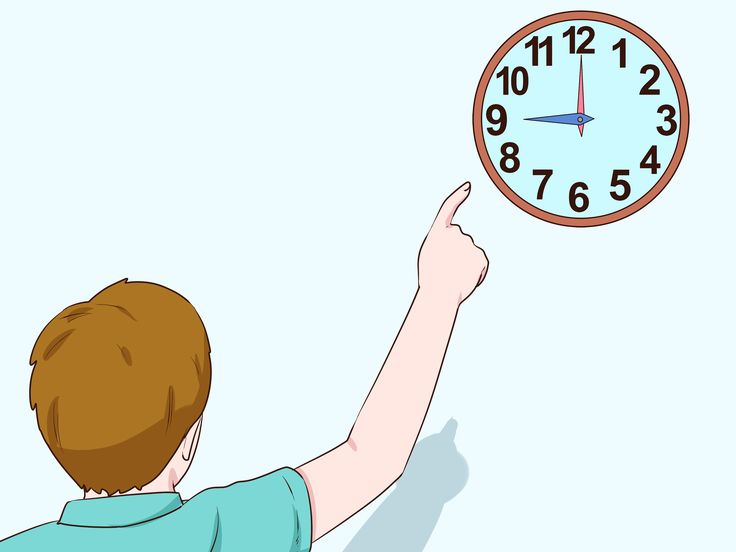
7. Explain that one division on a clock equals one minute. You will also need to memorize multiples of 5 (5, 10, 15…60). The child will remember faster if you say that these are numbers ending in 0 and 5.
8. Using the layout, we explain where the minute hand should be when the time is 09:15, 09:30, 09:45. Do not forget to tell us what half an hour, a quarter of an hour is, and consolidate the knowledge gained with the help of a layout.
DIY clock making
To practice the acquired skills, we need a model of a watch. For these purposes, you can use the dial of an old unnecessary watch. It is enough to remove the glass so that you can turn the arrows by hand. But you can make a watch yourself.
- You will need a plastic plate or a circle made of cardboard - the basis of future watches.
- From colored cardboard, make 2 hands: a small one for hours and a long one for minutes.
- We draw the base in half vertically and horizontally, designate the first numbers.
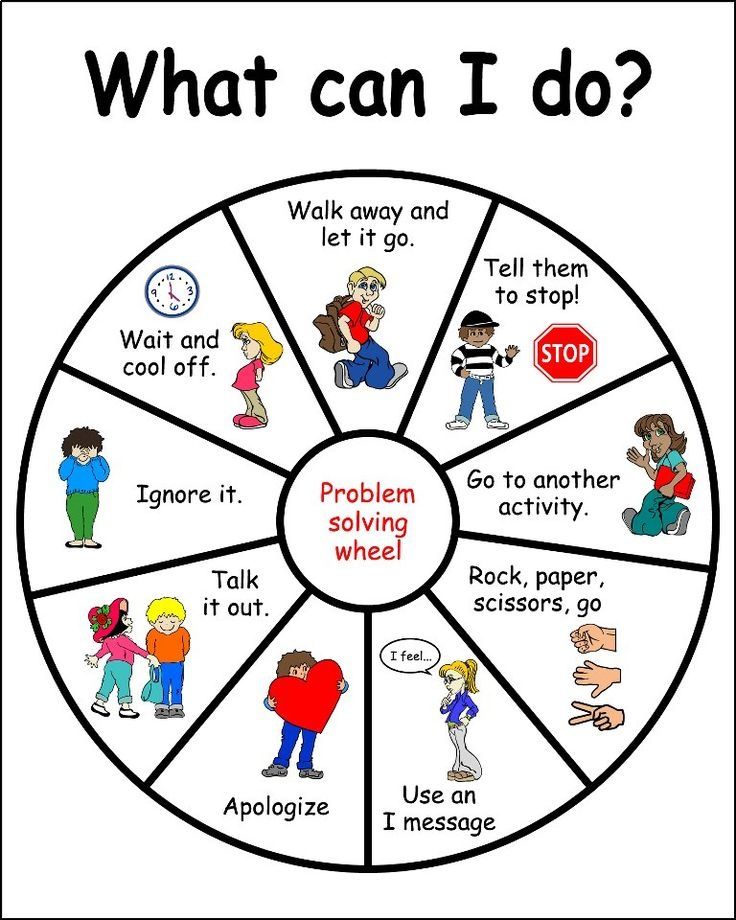 We divide the resulting quarters into three more parts and add the missing numbers.
We divide the resulting quarters into three more parts and add the missing numbers. - We attach the arrows to the base using a button. Your layout is ready!
Tip: Make this mock-up with your child. Entrust him with the manufacture of arrows, writing numbers. Speak and comment on your actions, repeating the material along the way.
Games and tasks with a clock to consolidate the result
Do not forget to use time frames in everyday life, for example: "Let's wash ourselves in five minutes" or "Turn on the TV in 10 minutes." Buy a watch for your child, and let the family often ask the baby what time it is.
And to make the consolidation of the material fun and accessible for the baby, play with it.
Psychic . Take a clock layout and cover the numbers indicated by the arrows with a piece of paper. The task of the child is to remember the location of the numbers on the dial and determine the time.
Timing.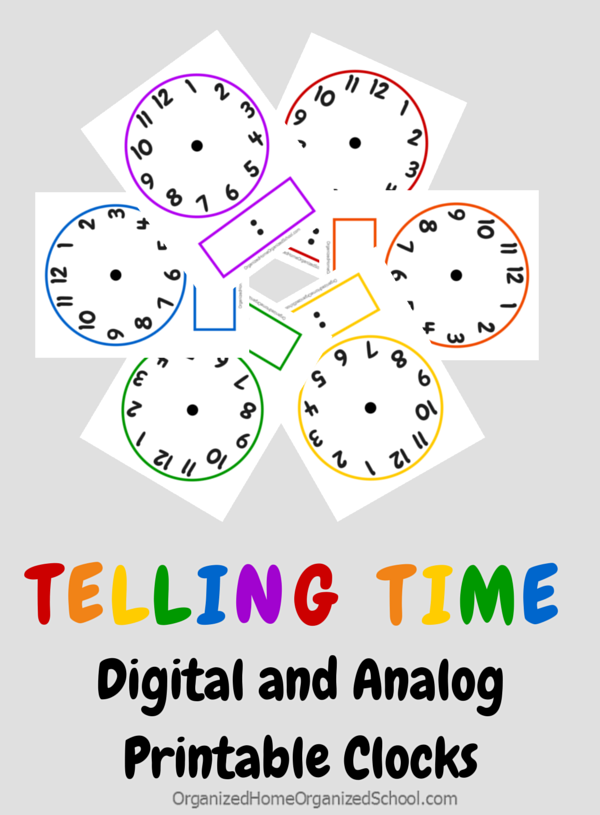 An adult tells a child's favorite fairy tale, but with temporary additions. For example, at 23:59 Cinderella ran out of the palace. The task of the child is to show 23:59 on the clock layout.
An adult tells a child's favorite fairy tale, but with temporary additions. For example, at 23:59 Cinderella ran out of the palace. The task of the child is to show 23:59 on the clock layout.
"Daytime" . Try to make with a preschooler his daily routine for tomorrow. Illustrate and indicate time periods.
Find a Pair . We will need an A4 sheet with a drawn clock and small pieces of paper on which time intervals will be written (for example, 02:50 or a quarter to twelve). The child will need to find a matching pair.
Poems about time for children
In teaching children, and especially preschoolers, not only games and tasks, but also poems can be used. Rhyming lines are well remembered and help the baby cope with difficulties.
Clock
They say the clock is standing.
They say the clock is fast.
They say: the clock is running,
But they are a little behind.

